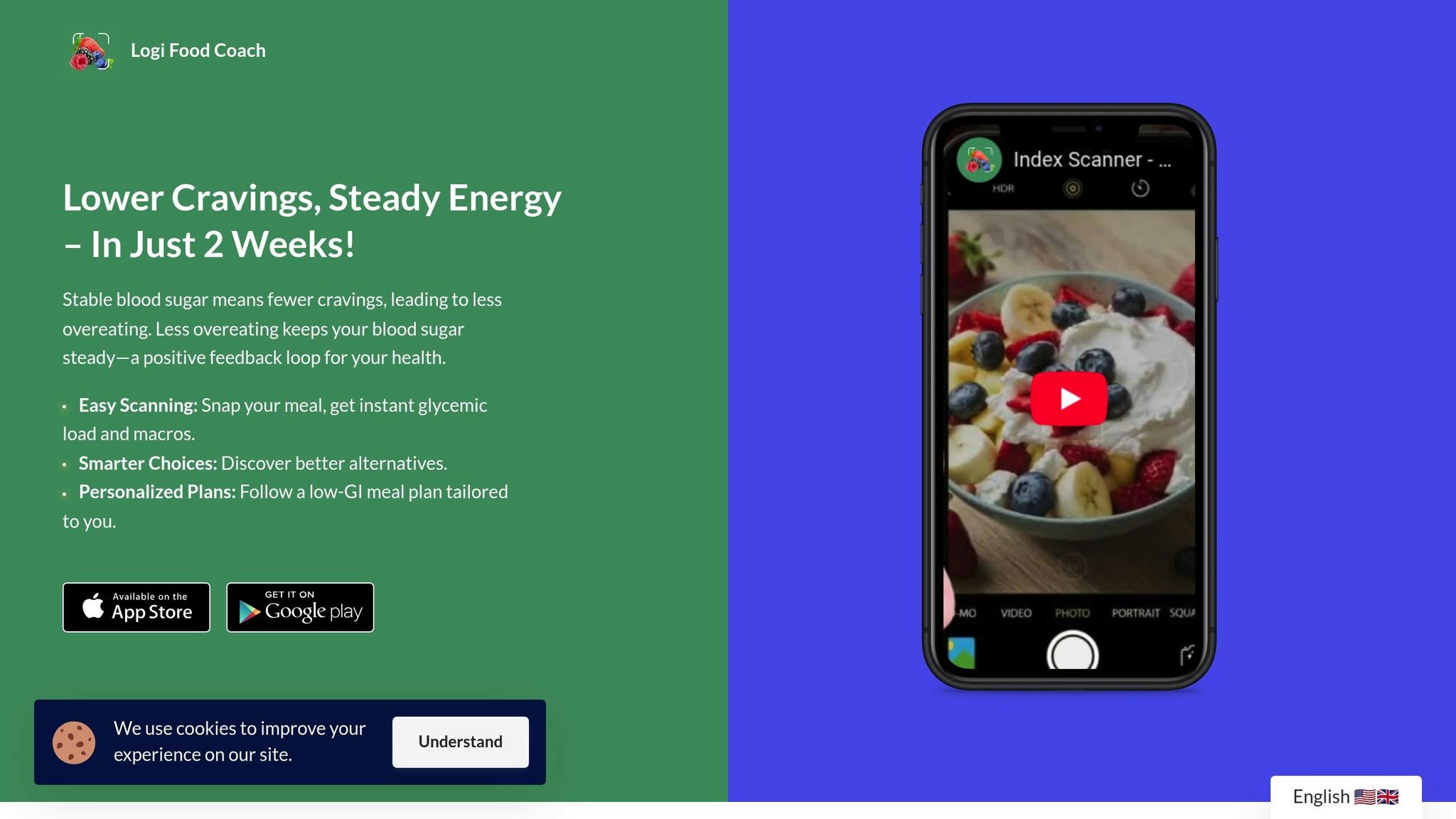Fiber is crucial for managing blood sugar levels. It slows carbohydrate digestion, prevents sugar spikes, and ensures steady energy. Here's what you need to know:
- Soluble Fiber: Forms a gel in water, slowing glucose absorption and reducing blood sugar spikes.
- Insoluble Fiber: Adds bulk to your diet, supports digestion, and indirectly helps regulate blood sugar.
Quick Tips:
- Best Sources: Legumes, whole grains, vegetables, fruits (with skin), and seeds.
- Daily Goal: 20–35g of fiber (most people only get 10–15g).
- Simple Habits: Keep skins on fruits, steam veggies, and add seeds to meals.
Digital tools like Logi's meal scanner can help track fiber intake and its effects on blood sugar. Start small, increase fiber gradually, and combine both types for the best results.
Roles of Fiber for Better Blood Sugar Management
How Different Fibers Affect Blood Sugar
Soluble and insoluble fibers help manage blood sugar in different ways, each playing a unique role in the process.
Soluble Fiber's Role in Slowing Digestion
When soluble fiber mixes with water, it forms a gel-like substance that slows down how quickly food leaves the stomach. This delayed digestion helps reduce sugar absorption, leading to smaller blood sugar spikes after meals. Studies show that adding just 13 grams of soluble fiber to your daily diet can lower HbA1c levels by about 0.6%. On the other hand, insoluble fiber impacts blood sugar through indirect but equally important metabolic effects.
Insoluble Fiber and Its Indirect Benefits
Insoluble fiber works differently, offering indirect support for blood sugar management through:
- Improved Gut Health: Encourages the growth of beneficial bacteria that support overall metabolic function.
- Increased Food Bulk: Adds volume to meals, aiding digestion.
- Enhanced Fullness: Helps you feel full longer, which can control portion sizes and reduce overeating.
When gut bacteria ferment insoluble fiber in the large intestine, they produce short-chain fatty acids (SCFAs). These SCFAs activate hormones like GLP-1 and peptide YY, which work together to slow stomach emptying, boost insulin secretion, reduce glucagon (a hormone that raises blood sugar), and curb appetite. This mechanism even leads to a "second-meal effect", where eating fiber at one meal improves blood sugar regulation during the next meal - even if the second meal is lower in fiber.
To get the best blood sugar control, aim to include both types of fiber in your diet. While most Americans only consume about 10–15 grams of fiber daily, experts recommend increasing that to 20–35 grams. Just remember to add fiber gradually to avoid digestive discomfort and allow your body to adjust, so you can fully benefit from the complementary effects of soluble and insoluble fibers.
Adding More Fiber to Your Diet
Best Foods for Fiber and Blood Sugar
When it comes to stabilizing blood sugar levels, whole, unprocessed foods rich in both soluble and insoluble fiber are key. Here’s a breakdown of some great options:
| Food Category | Examples | Fiber per Serving | Type of Fiber |
|---|---|---|---|
| Legumes | Black beans, lentils, chickpeas | ~15g per cup | Both types |
| Whole Grains | Oats, quinoa, barley | 4–6g per cup | Both types |
| Vegetables | Broccoli, Brussels sprouts, carrots | 4–5g per cup | Both types |
| Fruits | Apples, pears, berries | 3–4g per piece | Primarily soluble |
| Seeds | Chia seeds, flax seeds | ~7–10g per oz | Both types |
These foods not only boost your fiber intake but also help release glucose gradually, keeping your energy steady throughout the day.
Food Prep Tips for Maximum Fiber
A few simple kitchen habits can help you retain and even enhance the fiber content in your meals:
- Keep the Skin On: The skins of many fruits and vegetables are loaded with fiber, so avoid peeling when possible.
- Steam Instead of Boil: Steaming vegetables helps retain more fiber compared to boiling, which can cause some loss.
- Add Seeds to Meals: Stir ground flax or chia seeds into yogurt, oatmeal, or smoothies for an easy fiber boost.
- Choose Whole Grains: Replace white rice with brown rice or quinoa, and opt for whole-grain bread instead of refined versions.
If you’re looking for a convenient way to track fiber intake and monitor your blood sugar, tools like Logi’s meal scanner can be a helpful addition. For those who struggle to meet their fiber goals through food alone, supplements can fill the gap.
Guide to Fiber Supplements
While whole foods should be your primary source of fiber, supplements can help when your diet falls short. Here’s what you need to know:
Types of Fiber Supplements
- Psyllium: One of the most researched options, often linked to better blood sugar control.
- Methylcellulose: A gentler option for those with sensitive digestion.
- Inulin: Provides prebiotic benefits, though it may cause bloating or discomfort for some.
Supplement Guidelines
- Start with 3–5g daily and gradually increase to avoid digestive issues.
- Always take supplements with at least 8 oz (240 mL) of water.
- Space fiber supplements at least two hours apart from medications to avoid interference.
- Look for third-party-tested products to ensure quality and purity.
Using digital tools like Logi’s meal tracker can make it easier to monitor your fiber intake and how it interacts with your blood sugar levels.
sbb-itb-0899721
Research on Fiber and Blood Sugar
Gut Bacteria and Fiber Processing
Dietary fiber plays a key role in supporting a healthy gut microbiome. When beneficial gut bacteria ferment fiber, they produce short-chain fatty acids, which can influence glucose metabolism. While the precise effects are still being studied, it's clear that a fiber-rich diet helps maintain a diverse gut microbiome - an important factor for stable blood sugar levels. These findings highlight the potential of using digital tools to track fiber consumption and its impact on blood sugar management.
Digital Tools for Fiber Tracking
Keeping track of fiber intake and its impact on blood sugar levels has never been easier, thanks to technology. Digital tools not only simplify the process but also provide valuable insights into dietary habits, helping you maintain the right amount of fiber for better glycemic control. These tools work hand-in-hand with the dietary strategies discussed earlier.
Monitoring Fiber with Logi

Logi's meal glycemic load scanner takes the guesswork out of understanding your food. It breaks down the nutritional content of your meals, highlighting both soluble and insoluble fiber and their effects on blood sugar levels. With Logi, you can:
- Keep tabs on your total fiber intake
- View detailed nutritional breakdowns of your meals
- Identify eating patterns over time
The app also offers personalized health insights, showing how your fiber consumption aligns with blood sugar stability. Using this data, you can make smarter dietary choices. On top of that, Logi's smart meal recommendations help you refine your eating habits even further.
Smart Meal Recommendations
Logi’s recommendation system is like having a personal nutritionist in your pocket. It suggests fiber-rich alternatives tailored to your eating habits and blood sugar goals. The low GI/GL (glycemic index/glycemic load) food finder introduces you to new high-fiber options that support steady blood sugar levels.
| Meal Type | Benefits of Fiber-Rich Choices |
|---|---|
| Breakfast | Helps prevent blood sugar spikes to start your day right |
| Lunch | Provides balanced energy with optimal fiber content |
| Dinner | Combines protein and fiber for improved glycemic control |
For those looking for more advanced features, Logi offers two subscription options. The Premium plan, priced at $9.99 per month, provides enhanced insights and personalized recommendations. The Pro plan, at $19.99 per month, delivers in-depth analytics for a comprehensive approach to managing blood sugar levels. These tools are a perfect addition to the dietary strategies already discussed, helping you stay on top of your health goals.
Conclusion: Making Fiber a Daily Habit
Why Fiber Matters
Fiber plays a key role in managing blood sugar levels and supporting overall health. Soluble fiber slows digestion, helping to prevent sudden blood sugar spikes, while insoluble fiber promotes digestive health and steady insulin function. The secret to success? Consistently incorporating both types of fiber into your daily diet.
By paying attention to the fiber content in your meals, you can make smarter food choices that align with your health goals. Combining mindful eating with regular monitoring creates a strong foundation for long-term positive changes.
Tools to Help You Stay on Track
Digital tools can make sticking to these habits easier. Logi’s features, like its meal scanner and daily log, are designed to help you optimize your fiber intake and maintain stable blood sugar levels.
| Tracking Feature | How It Helps with Blood Sugar Control |
|---|---|
| Meal Scanner | Identifies fiber content and glycemic load of foods |
| Daily Log | Tracks patterns in your fiber consumption |
| Health Insights | Links fiber intake to blood sugar stability |
| Alternative Finder | Recommends high-fiber, low-glycemic options |
Achieving better blood sugar control starts with informed choices. Small, consistent changes - like increasing your fiber intake - can make a big difference over time. With tools like Logi, you’ll have the support you need to stay on track and meet your health goals.
FAQs
How can I increase my fiber intake without causing digestive discomfort?
To ease into a higher-fiber diet and sidestep any digestive issues, begin by incorporating small portions of fiber-rich foods like fruits, vegetables, whole grains, and legumes into your meals. Gradually increase the amount over several weeks, allowing your digestive system to adapt at its own pace.
Don’t forget to stay well-hydrated. Fiber works by absorbing water, which helps keep food moving smoothly through your system. Without enough water, you might deal with bloating or constipation. By slowly adjusting your intake and drinking plenty of water, you can reap the benefits of fiber without any unnecessary discomfort.
How can digital tools like Logi help track fiber intake and manage blood sugar levels?
Digital tools like Logi simplify managing blood sugar levels by offering features designed to fit your nutritional needs. For instance, Logi's meal glycemic load scanner calculates the glycemic load of your meals, giving you a clear picture of how carbohydrates and fiber are balanced in your diet.
It also includes a daily meal tracker that lets you log your meals, keep tabs on your nutritional intake, and spot patterns in your eating habits. On top of that, Logi provides personalized health insights for every meal and recommends low GI/GL food alternatives to guide you toward smarter food choices. These tools make it easier to stay on top of your blood sugar and energy levels without much hassle.
What is the 'second-meal effect,' and how can I use it to better manage my blood sugar levels?
The 'second-meal effect' is a fascinating concept where the type of food you eat during one meal can positively impact your blood sugar levels after your next meal. Specifically, meals rich in dietary fiber, especially soluble fiber, play a key role. Soluble fiber slows down digestion and helps steady blood sugar levels by reducing how quickly glucose enters your bloodstream.
To make this part of your daily habits, focus on including fiber-packed foods like oats, beans, lentils, leafy greens, and fruits with their skins in your meals. For instance, starting your day with a high-fiber breakfast can help keep your blood sugar stable through lunch. And if you want to take it a step further, using tools like the Logi - Glycemic Index Tracker App can help you monitor the glycemic impact of your meals and find low-GI foods to support better blood sugar control.



